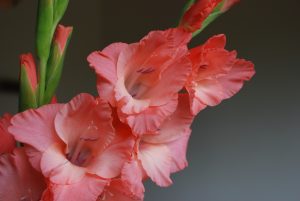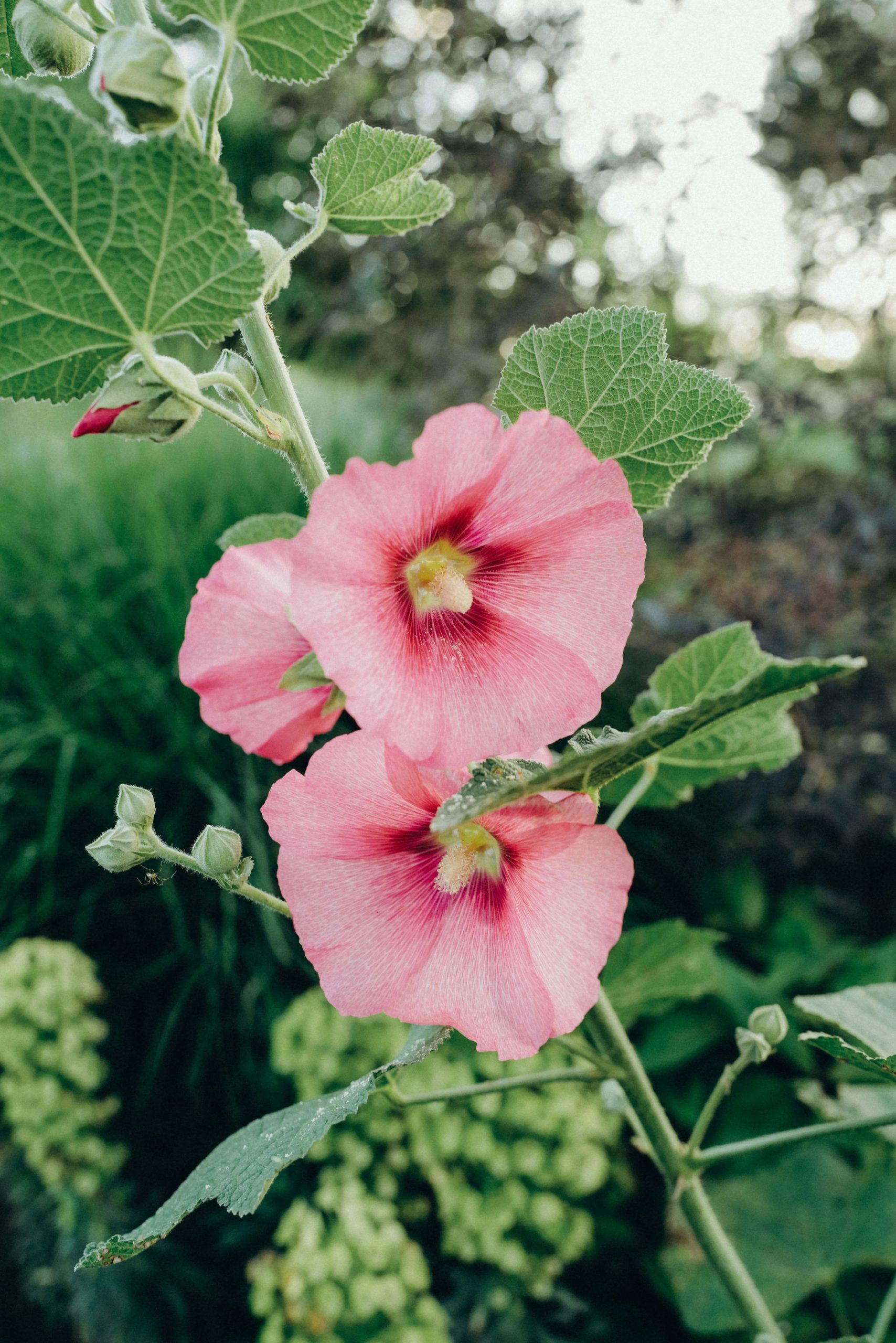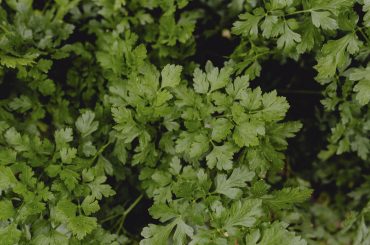In horticulture, hollyhock and gladiolus are timeless favorites, adored by garden enthusiasts for their remarkable beauty and captivating presence. These two flowers, each possessing their unique charm, have garnered a special place in the hearts of plant lovers worldwide. In this article, we embark on a journey to explore the similarities and differences between hollyhock and gladiolus, shedding light on their distinct characteristics and sharing insights into why they have become such beloved choices among gardeners.
Hollyhock, known for its majestic tower of beauty, adorns gardens with its tall and erect stature, reaching impressive heights of 5 to 8 feet. Its large, showy flowers, available in shades of pink, purple, white, and yellow, create a visual spectacle that enchants all who behold them. Meanwhile, with its elegance of vertical blooms, gladiolus introduces a vertical dimension to landscapes, showcasing flower spikes adorned with a vibrant array of colors. From radiant reds and oranges to delicate pinks and purples, gladioli offer an extensive palette to inspire awe.
Both hollyhock and gladiolus have secured their place in the hearts of garden enthusiasts, earning popularity for their ability to transform gardens into stunning displays of nature’s artistry. Their allure lies in their striking visual appeal and their versatility in garden design and floral arrangements. These flowers can captivate attention as majestic focal points or complementary elements within a carefully curated landscape.
This article aims to delve into the world of hollyhock and gladiolus, examining their similarities and differences to aid gardeners in making informed decisions about which flower to cultivate in their cherished spaces. By exploring their appearance, growth requirements, uses, and symbolic meanings, we aim to provide a comprehensive guide that celebrates the unique qualities of each flower and assists in selecting the perfect addition to one’s garden.
Join us as we embark on this journey of discovery, where we unravel the secrets behind the popularity of hollyhock and gladiolus, unearthing the intricacies of their growth and uncovering the hidden meanings behind their blooms. Whether you seek the regal presence of the hollyhock or the elegance of the gladiolus, this article will serve as your companion, helping you make an informed choice to enhance your garden’s beauty and create a harmonious oasis of floral enchantment.
Contents
Hollyhock: The Majestic Tower of Beauty
With its awe-inspiring height and captivating beauty, the hollyhock (Alcea rosea) stands as a majestic tower of floral elegance within the world of garden flora. Let us delve into the enchanting characteristics of this beloved flower, exploring its appearance, growth requirements, ornamental uses, and potential cultural and historical significance.
Appearance:

Hollyhocks are a sight to behold, boasting tall and erect stems that can reach impressive heights of 5 to 8 feet. The plant’s elongated, heart-shaped leaves provide a lush backdrop for the main attraction – the large, showy flowers. Hollyhock blooms take the form of a cup or saucer, delicately arranging petals around a central cluster. These exquisite flowers come in enchanting hues, including shades of pink, purple, white, and yellow, with some varieties even displaying captivating bi-color combinations. The towering height and vibrant colors of hollyhock blooms make them a striking focal point in any garden landscape.
Growth and Care Requirements:
To cultivate hollyhocks successfully, providing the right growing conditions is essential. These biennial or short-lived perennial plants thrive in full sun, basking in its warm rays throughout the day. Well-draining soil is crucial for their healthy development, as excessive moisture can lead to root rot. When planting hollyhocks, it is best to sow the seeds directly in the garden in the early spring or late summer.
Alternatively, young plants can be purchased and transplanted. As the plants grow, they may require staking or support due to their towering height and susceptibility to strong winds. Regular watering, especially during dry spells, is important to moisten the soil. Pruning spent blooms can encourage continuous flowering, while removing diseased leaves or stems helps maintain plant health.
Ornamental Uses and Benefits in Garden Landscapes:
Hollyhocks are cherished for their ornamental value, adding a touch of grandeur and vertical interest to garden landscapes. These majestic flowers are commonly used in the back of flower beds, borders, and cottage-style gardens, where their tall stature can create a dramatic backdrop or act as a focal point. Hollyhocks are excellent companions to other plants, providing a striking contrast to lower-growing species and enhancing the overall aesthetic appeal of the garden. Additionally, hollyhocks attract pollinators like bees and butterflies, contributing to the ecosystem and promoting biodiversity.
Cultural and Historical Significance:
Throughout history, hollyhocks have held cultural and historical significance in various societies. In some cultures, these flowers symbolize fertility, abundance, and protection. Their tall and regal presence has made them popular for ceremonial decorations, garden parties, and special events. In addition, hollyhocks have been used in traditional herbal remedies for medicinal purposes, believed to possess healing properties for ailments such as respiratory issues and digestive complaints.
Gladiolus: The Elegance of Vertical Blooms
With its graceful stature and vertical splendor, gladiolus (Gladiolus spp.) emerges as a captivating flower that adds a touch of elegance to any garden landscape. Let us explore the enchanting features of this beloved flower, including its appearance, growth requirements, versatility in design, and potential symbolic meanings and cultural associations.
Appearance:
Gladiolus is a beacon of beauty, showcasing its distinctive vertical blooms. These flowering spikes, or inflorescences, can reach impressive heights ranging from 2 to 5 feet. The gladiolus boasts long, sword-shaped leaves that provide a striking backdrop to the breathtaking array of blossoms. The flowers, arranged in succession along the sturdy stems, come in an extensive palette of vibrant colors. From radiant reds, oranges, and yellows to delicate pinks, purples, and whites, gladiolus offers a kaleidoscope of hues that mesmerizes the beholder.
Growth and Care Requirements:
For the successful cultivation of gladiolus, understanding its growth requirements is crucial. These cormous perennials thrive in full sun, requiring at least 6 to 8 hours of direct sunlight daily. Well-draining soil is essential to prevent waterlogging, as excessive moisture can lead to the rotting of the corms. Planting is typically done in the spring after the threat of frost has passed. The corms should be placed about 4 to 6 inches deep, with proper spacing for adequate air circulation.
Regular watering is necessary to keep the soil moist during the growing season, especially during dry periods. To support the tall flower spikes and prevent them from bending or breaking, staking or using supports is recommended. After the blooming season, corms can be dug up and stored over winter in colder climates to protect them from frost.
Versatility in Garden Design and Floral Arrangements:
Gladiolus offers versatility in garden design, making it a popular choice among landscape enthusiasts. The vertical structure of gladiolus makes it ideal for creating height variation in garden beds, borders, and mixed flower arrangements. Planting gladioli in clusters or rows can provide a stunning visual impact while interspersing them with lower-growing plants adds dimension and interest to the overall design. Furthermore, gladiolus blooms are highly sought-after in floral arrangements, bringing an air of sophistication and elegance to bouquets, centerpieces, and other decorative displays.
Symbolic Meanings and Cultural Associations:

Gladiolus holds symbolic meanings and cultural associations that have captivated various societies throughout history. These flowers often represent strength, integrity, and moral character. Their tall and upright presence has made them an emblem of resilience and determination. In some cultures, gladioli are also associated with remembrance, making them a fitting choice for memorial services or tributes. Gladiolus’s profound symbolism and cultural significance add depth and meaning to their allure.
A Side-by-Side Comparison: Hollyhock vs. Gladiolus
A side-by-side comparison can help you make an informed decision when choosing between hollyhock and gladiolus for your garden. Let’s explore the similarities and differences between these two beloved flowers regarding their appearance and structure, growing conditions and maintenance, bloom characteristics and color variations, and their uses in landscaping and floral arrangements. We’ll also delve into any symbolic and cultural significance associated with these flowers, if applicable.
Appearance and Structure:
Hollyhock: Known for its towering height, the hollyhock stands tall, reaching impressive heights of 5 to 8 feet. It features a straight and erect stem adorned with large cups or saucer-shaped flowers in shades of pink, purple, white, and yellow. The flowers are arranged in a cluster, creating a visually striking display.
Gladiolus: In contrast, gladiolus also boasts verticality but with a more slender and graceful form. Its flower spikes can range from 2 to 5 feet in height and are adorned with multiple blooms that open in succession along the stem. Gladiolus offers a diverse color palette, from vibrant reds, oranges, and yellows to delicate pinks, purples, and whites.
Growing Conditions and Maintenance:
Hollyhock: Hollyhocks thrive in full sun, requiring at least 6 hours of direct sunlight daily. They prefer well-draining soil and need regular watering to keep the soil moist. Staking may be necessary to support their tall stems. Hollyhocks are generally hardy but can be susceptible to diseases such as rust, requiring proper care and monitoring.
Gladiolus: Gladioli also prefer full sun, with a similar requirement of 6 to 8 hours of direct sunlight per day. They require well-draining soil and regular watering to keep the soil moist. Staking is often necessary to support their tall flower spikes. Gladiolus corms can be dug up and stored in colder climates during the winter to protect them from frost.
Bloom Characteristics and Color Variations:
Hollyhock: Hollyhock flowers are large and showy, with a cup or saucer shape. They come in shades of pink, purple, white, and yellow; some varieties may display captivating bi-color combinations. The flowers are visually striking and create a bold statement in the garden.
Gladiolus: Gladiolus flowers are smaller than hollyhocks but are arranged in clusters along the tall spikes. They offer various colors, including vibrant reds, oranges, yellows, pinks, purples, and whites. The flowers open in succession from bottom to top, prolonging the blooming period and adding a dynamic element to the garden.
Uses in Landscaping and Floral Arrangements:
Hollyhock: Hollyhocks make stunning focal points in the garden, especially when planted in the back of flower beds or borders. Their tall stature adds vertical interest and drama to the landscape. In floral arrangements, hollyhock blooms create a striking presence, either on their own or paired with other complementary flowers.
Gladiolus: Gladiolus is a versatile flower in garden design. Its vertical form adds height and structure, making it suitable for creating visual interest in borders, mixed plantings, or as a standalone feature. In floral arrangements, gladiolus spikes add elegance and sophistication, lending themselves well to tall vase displays or as accents in bouquets.
Symbolism and Cultural Significance:
Hollyhock: While hollyhock does not carry as much symbolic or cultural significance as gladiolus, it has been associated with fertility, abundance, and protection in some cultures. Its regal presence has made it popular for ceremonial decorations and garden parties.
Gladiolus: Gladiolus holds various symbolic meanings, including strength, integrity, and moral character. Its tall and upright nature has made it a symbol of resilience and determination. Gladiolus is often associated with remembrance and can be fitting for memorial services or tributes.
Choosing the Perfect Flower for Your Garden
When deciding between hollyhock and gladiolus, several factors must be considered to ensure you select the perfect flower for your garden. Let’s explore these factors, including the considerations when choosing between hollyhock and gladiolus, ideas for complementary plants and companion planting, and the long-term benefits and considerations for each flower.
Factors to Consider:
- Climate and Growing Conditions: Assess your garden’s specific climate and growing conditions. Consider the sunlight exposure, soil type, and drainage requirements. Both hollyhock and gladiolus prefer full sun, but hollyhock may be more tolerant of varying soil conditions.
- Garden Design and Aesthetic: Reflect on your desired garden design and the overall aesthetic you wish to achieve. Hollyhock’s towering presence and showy blooms make it ideal as a focal point or a backdrop in cottage-style or traditional gardens. With its vertical elegance, gladiolus can add height and structure to borders or mixed plantings.
- Maintenance and Care: Evaluate the maintenance and care requirements of each flower. Hollyhock may require staking to support its tall stems and monitoring for diseases such as rust. Gladiolus may also need staking, and the corms may require winter storage in colder climates.
Complementary Plants and Companion Planting:
Consider the potential for complementary plants and companion planting ideas to enhance your garden’s visual appeal and health.
- Complementary Plants: Explore plants that pair well with hollyhock or gladiolus to create harmonious and eye-catching combinations. For hollyhock, consider lower-growing plants such as lavender, salvia, or catmint as companions. Shorter annuals like marigolds or zinnias can complement gladiolus.
- Companion Planting: Enjoy companion planting benefits to promote growth and discourage pests. Pairing hollyhock with herbs like borage or chamomile can attract beneficial insects and deter pests. Gladiolus can benefit from neighboring plants like dahlias or daylilies, which provide shade to their corms.
Long-Term Benefits and Considerations:

Consider the long-term benefits and considerations associated with each flower.
- Hollyhock: Hollyhock is a hardy perennial or biennial flower that can establish itself in the garden and provide years of beauty. It’s showy blooms and tall stature make it a stunning addition to the landscape. However, hollyhocks may require regular maintenance and monitoring for disease, and their self-seeding nature should be considered.
- Gladiolus: Gladiolus offers a vibrant display of vertical blooms and a wide range of color options. They are a striking presence in the garden and excellent for cutting flower arrangements. However, gladiolus corms may need to be dug up and stored in colder climates to protect them from frost, adding an extra step to their long-term care.
Conclusion:
In conclusion, both hollyhock and gladiolus offer unique qualities and bring their charm to garden landscapes. Let’s recap the key points discussed and encourage gardeners to explore the beauty and versatility of both flowers.
Our exploration revealed that the hollyhock captivates with its towering height, cup or saucer-shaped flowers, and diverse colors. Its maintenance requirements and susceptibility to diseases should be considered, but Hollyhock’s presence as a focal point or backdrop in the garden is unmatched.
On the other hand, gladiolus enchants with its slender form, sheer elegance, and stunning array of blooms that open in succession. Its wide range of vibrant colors adds depth and vibrancy to any garden design. While gladiolus requires staking and may need winter storage in colder climates, its versatility in borders, mixed plantings, and floral arrangements make it a popular choice.
As gardeners, we are fortunate to have the opportunity to explore and cultivate these remarkable flowers. Embrace the unique qualities of hollyhock and gladiolus in your garden, and let their beauty shine. Consider the climate and growing conditions of your garden, the design aesthetic you wish to achieve, and each flower’s long-term benefits and considerations.
Whether you choose the majestic tower of beauty that is hollyhock or the elegance of vertical blooms offered by Gladiolus, you can create a garden filled with splendor and visual interest. These flowers enhance the aesthetics of your outdoor spaces and provide a canvas for creativity in floral arrangements.
So, embark on your gardening journey, exploring the unique qualities of hollyhock and gladiolus. Let their captivating presence and versatility inspire you to create breathtaking landscapes that bring joy and admiration to all who behold them. Embrace their beauty, experiment with companion plants, and watch your garden come to life with vibrant colors and exquisite forms.
More Posts :
Mastering the Art of Growing and Caring for Jacaranda Trees in Texas: Expert Tips for 2023
Bitter Blackberries Unveiled: Unraveling the Secrets of Taming the Taste | 2023 Edition





